Abstract
The production of synthetic iron castings in Russia comprises 50% of all alloys produced; therefore, increasing their smelting efficiency is an urgent task in the industry. This process depends primarily on the efficiency of industrial frequency induction crucible furnaces using acid lining. In the present study, the properties of quartzite, which forms the basis of such a lining, were investigated. An analysis of the proposed variants for changing the composition of the acid lining for use at temperatures of 1550–1600 °C was conducted. Following the preliminary temperature treatment of raw quartzite, which was then subjected to a sintering regime, we determined the conditions under which it was possible to obtain a phase state, allowing for the operation of the lining at temperatures above 1450 °C. We determined the use of an electrocorundum of two fractions as an additive to the traditional composition of the acid lining. The industrial testing of a new liner composition for the smelting of synthetic cast iron in an induction crucible melting furnace with a single steel scrap-metal filling was assessed, which required the use of an increased amount of carburizing agent. The positive results obtained can be explained by the study of the spent lining, which withstood 345 smelting methods of genophasic rent analysis. The results of the test are based on the results obtained in a study conducted on the finished coating of the product.
1. Introduction
The development of the smelting industry is directly related to the creation and further development of foundries, which are, at present, the most popular method for producing blanks [1]. The requirements for producing castings are determined by the entire cycle of the process; however, the most important factor to consider is the composition and technology used for the preparation of alloys. The quality, costs, and environmental issues concerning the products, compared against the backdrop of increasing economic changes in recent years, as well as the optimal price–quality ratio, determine the competitiveness of processes, products, and companies in general.
For this reason, the key to the successful development of foundries is a constant advancement in the scientific and technical levels of production through the creation and implementation of the most effective forms of technology, machines, and equipment in the field. In addition, the increasing costs of raw materials, energy, wages, and environmental protection measures require more efficient processes. This is facilitated by increasing labor productivity rates, improving product quality, saving resources, and saving energy. In the foundry industry, first of all, this concerns the wider use of induction crucible furnaces (ICFs) for smelting cast iron used in the manufacture of castings. These furnaces have been in use in the industry since the 1950s and have been used for the smelting of synthetic iron, using steel scrap metal, in the form of sheet trimmings, chips, and other small-volume waste materials [2,3,4]. The distribution of these items in Russia is presented in Figure 1, making up 82% of the total sum [5].
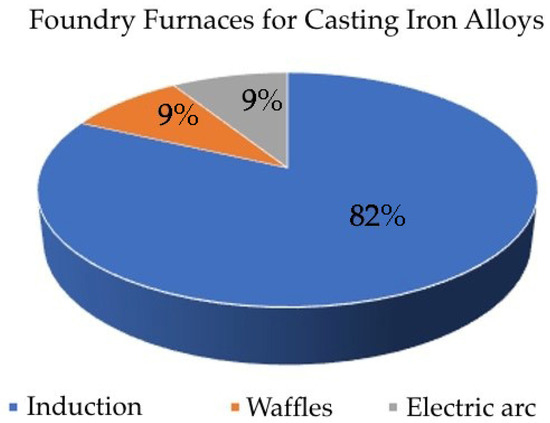
Figure 1.
Foundry iron smelters.
ICFs were designed to smelt synthetic cast iron using metal fillings, where the amount of steel scrap metal used should not exceed 30–35%. For this purpose, the melting capacity of the furnace is 1450–1500 °C and an acid quartzite-based lining is used, which is the cheapest material available. When operating these furnaces, their high reliability, ease of maintenance, and high resistance to the acid lining, reaching 300–350 melts, have been observed. Synthetic cast iron smelting in ICFs allows for the deep thermal treatment, refining, modification, and alloying of liquid metal and the production of alloys with predetermined properties superior to cast iron obtained by the wax smelting method [6,7,8,9]. In addition, induction melting contributes to the destruction of the imperfect structure of initial charge materials. These factors make it possible to obtain cast iron of any chemical composition and present the prerequisites for reducing the wall thickness of castings and increasing the durability of engineering parts produced [10,11,12,13].
The essence of the synthetic iron smelting process consists of the saturation of an alloy obtained from a metal filling consisting of casting iron, steel, and iron scraps; carbon and silicon in the necessary proportions; and the application of high-temperature processing treatments. The main process of melting consists of the carburizing of metal, which largely determines the structure and quality of the castings produced [14].
2. Problem
Recently, numerous studies have been dedicated in the literature to the production of synthetic cast iron using an increased amount of steel scrap metal in a metal warehouse as the main way to further increase the efficiency of the production process [15,16,17]. This makes it possible to reduce the casting cost using cast iron by increasing the share of steel scrap metal as the cheapest material, compared to the cast iron secondary remelting process [18] and maintaining the possibility of using quartzite-based lining [19,20,21,22,23,24,25]. This is particularly relevant in the present context, where all countries are experiencing the effects of the pandemic and the ensuing energy crisis [26].
Table 1 presents the percentage of the metal used in this study and compares it with the standard values.

Table 1.
Synthetic iron smelter metal filling.
The increased use of steel scrap-metal content reduces the costs by 37–45%; however, this implies a two- to four-fold increase in the use of a carburizer and a melting temperature of 1560–1620 °C, which reduces the resistance of the acid lining with a value of 300–350 to 180–200 [24]. The reason for this is the increase in the carburization time resulting in a faster reaction (1):
SiO2 + 2C → Si + 2CO↑
This causes the rapid destruction (dissolution) of the lining. Moreover, this reduces production efficiency due to the forced downtime associated with the furnace overlining effect and increased material and electricity costs [27,28]. Thus, the turndown process (from the beginning of the furnace being shut down to the first full discharge of the completed melt) of ICF-1 lasts for 2.5 to 3 days, and these downtimes reduce the efficiency of the furnace’s operation. Thus, the problem of maintaining the resistance of the lining is of paramount importance. The use of other materials increases costs and provides less resistance. Therefore, corundum mass sold on the market costs RUB 70 per 1 kg, spinel-forming lining mass Coral CXL costs RUB 500 per 1 kg, the heat-resistant lining of induction furnaces for smelting alloy steel and cast iron at temperatures up to 1800 °C costs RUB 180 per 1 kg, and ground quartzite PCMVI 2 costs RUB 11 per 1 kg.
Quartzite-based acid lining is very stable if (following the sintering stage) it has three zones, sintered, semi-sintered, and loose (Figure 2); however, at temperatures above 1450 °C, the transition from one zone to another occurs much more quickly, which speeds up the wear process [29].
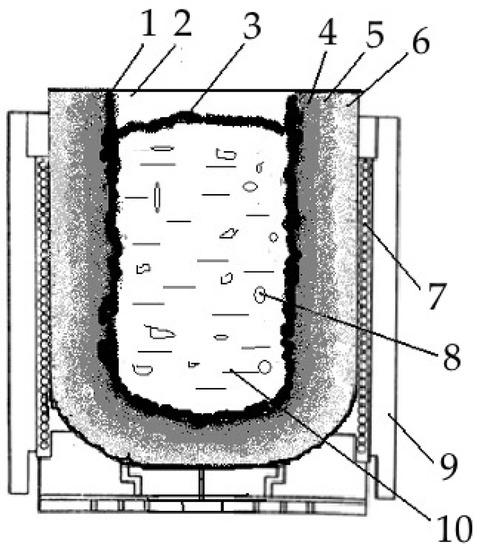
Figure 2.
Arrangement of the quartzite-based lining areas in the ICF, adapted from [11], where: 1—sanded concrete-lining crust; 2—gas phase of the furnace; 3—liquid slag on the surface of the melt; 4—sintered lining zone; 5—semi-welded lining zone; 6—the area of the unstable mass (buffer); 7—furnace inductor; 8—gas contained in the melt; 9—furnace body; 10—melt.
In the process of operating the furnace, all these zones are renewed; the lining becomes worn and must be replaced—after 300–350 smelting operations; however, this occurs only if the melting mode is not >1450 °C. Fenner C.N., conducted a detailed study of quartzite for the first time [30]. A diagram of the SiO2 single-component system considers that the changes occurring in quartzite at a temperature of 870 °C are insignificant and do not affect the production of refractory materials. This was also noted in the works [31,32,33]. To improve the acidic lining’s properties, repeated attempts were made in the research to apply additives obtained from a mixture of calcium, iron, sodium oxides, phosphorus-containing additives, special fritta, and alloys collected from a mixture of silica and sodium oxide or silica with iron oxides and calcium; finely ground trimmed dynas using a tridymite grinder; or a 30% corundum additive. High-temperature additives in the forms of ZrO2, Cr2O3, chromoglobulinum slag, and chromite were also proposed. However, these products have not been commercially applied. Recent studies have shown that, by creating conditions that allow us to obtain a phase condition of quartzite in the form of cristobalite, after sintering the acid lining, it retains its high resistance level [34,35,36]. Thus, in the study [37], the obtained quartzite presents a crystal lattice pattern consisting of phases of quartzite and cristobalite. The results of the average characteristics of the parameters of the quartzite lattice (including the phase composition) at different temperatures of pre-treatment and subsequent heating processes are presented in Table 2.

Table 2.
Average parameters and phase composition values of the quartzite crystal lattice, data from [37].
Industrial uses of this technology have shown its average durability level at 300 melts.
3. Materials and Methods
The aim of this study was to develop a new acid-lining composition that, due to the use of an additional additive, is stable and highly resistant at melting temperatures of 1560–1620 °C. Using this formulation, we developed alternative technology for the acid and sintering linings and conducted industrial tests.
To increase the fire-resistance and thermal-stability properties of the lining, we decided to investigate the possibility of using white electrocorundum, produced by “Jurginsky abrasives”, as presented in Table 3.

Table 3.
Fractions of white electrocorundum and its chemical state by technical condition (TC) 3987-027-00221066-01, data from [38].
Based on the diagram of the FeO–SiO2 system (Figure 3), we determined that the content of the electrocorundum in the Pervoural quartzite-based lining should not exceed 4%. An excess of this content can lead to the formation of light-melting silicate consisting of 40% SiO2, 10% Al2O3, and 50% FeO with a melting point of 1080 °C, which causes the lining to be severely worn when the melting temperature exceeds 1450 °C.
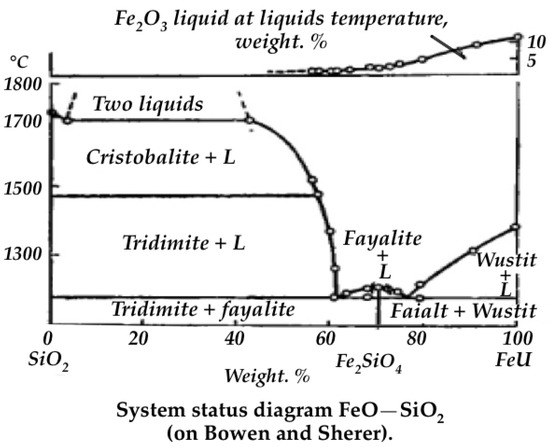
Figure 3.
Diagram of the FeO-SiO2 system, adapted from [39], where: 0—SiO2; 100—Al2O3; composition: percentage of total mass.
We decided to use two fractions, 0.125 and 0.315; their quantitative ratios were determined from the maximum preservation of the grain composition of the original quartzite sample. The checked sieves showed that, for the required number of fractions (passing through a 0.5-mesh grid), a composition of 46–51% instead of 48–52% was observed, and, in our opinion, it should not have led to the deterioration of the properties of the lining. In [40], a high penetration rate of slag melt containing more than 16% Al2O3 can be observed, resulting in the rapid formation of through holes in the quartzite lining.
The electrocorundum should form an aluminium silicate with a melting point of 1700 °C, which will increase the refractory strength and lining resistance of the material at temperatures above 1450 °C. Additionally, it is possible to form mullite 3Al2O3 · 2SiO2 (Al6Si2O15), which increases the fire- and chemical-resistance properties of the acid lining and reduces the penetration of oxide melts in the FeO–MnO–SiO2 system into a working layer of lining [40,41,42].
As a result, a refractory mass consisting of crystalline quartzite, boric acid, and an additive was proposed in the study in the form of a white-fraction electrocorundum of 0.315 mm and a white-fraction electrocorundum with the following component ratios (expressed as a percentage of the mass): crystalline quartzite 93.43–96.07; boric acid 0.67–1.21; 0.315 mm electrocorundum white fraction 2.75–4.15; and 0.125 mm electrocorundum white fraction 0.51–1.21. This composition, as shown in Table 4, is patented [43].

Table 4.
New composition of the lining mixture, data from [43].
Then, for one of the enterprises, a technological process was developed for the manufacture of a tiger lining of the ICF-1 kiln from a new composition with a sintering process, including the following operations:
- Drying of the quartzite in an oven, with the bottom rolled out at a temperature of 200 °C within 20 h.
- Mixing of all components in the grinding machine (Mod. 12221) for 1 h.
- Packing and sintering of the lining according to the existing technology.
- Kiln exposure at 1550–1600 °C for 2 h.
- Discharge of the first 5 melts with a volume not exceeding 0.3 of the volume of the furnace crucible.
Then, the continuous operation of the furnace ensured the production of liquid metal corresponding to the cast iron mark “CH20” GOST 1412-85 [44] (according to the international standard ISO 185 mark “200”) [45,46]. The metal filling only consisted of steel scrap metal, to which carburizer and ferroalloys were added, if necessary. According to the status indicator, the furnace was stopped after 345 melting processes. During the embossing process, a sample was obtained from the middle of the lining for further examination. Figure 4 presents photographs of the fusion process.
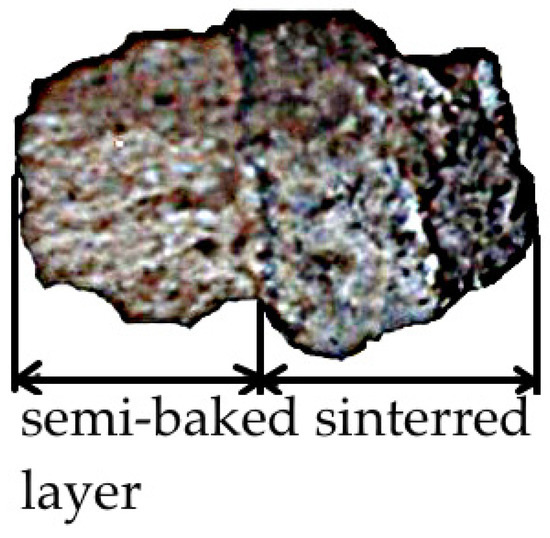
Figure 4.
Embossed sample.
The study used the X-ray diffraction method with the diffractometer BRUKER D8 ADVANCE (Bruker Corporation, Billerica, MA, USA), equipped with a Bragg-Brentano focusing geometry and a high-temperature camera, HTK 16 (Anton Paar GmbH, Anton Paar Strasse 20, 8054 GRAZ, AUSTRIA). A copper anode X-ray tube was used; the diffraction spectrum was recorded by a high-speed positional-sensitive detector VÅNTEC-1. The survey was performed at an angle of 2Θ = 10°–90°, with a step of 0.007.
4. Results
Figure 5 shows the diffractogram of the half-welded lining, which consists of a quartzite sample, the crystal lattice of which is characterized by card 00-003-0427 with cell sizes of z = 4.90300 Å and c = 5.39300 Å and cristobalite (card 01-085-0620) with cell size: z = 7.16000 Å.
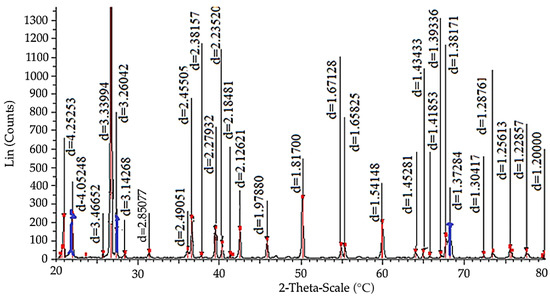
Figure 5.
The diffractogram of loose-layer embossed lining, removed at 25 °C, with the identification of pixels showing inter-dimensional distances:  —quartzite and
—quartzite and  —cristobalite.
—cristobalite.
 —quartzite and
—quartzite and  —cristobalite.
—cristobalite.
Figure 6 and Figure 7 show the cards (taken from the device database described above) that revealed the formed phase of the quartzite cells.
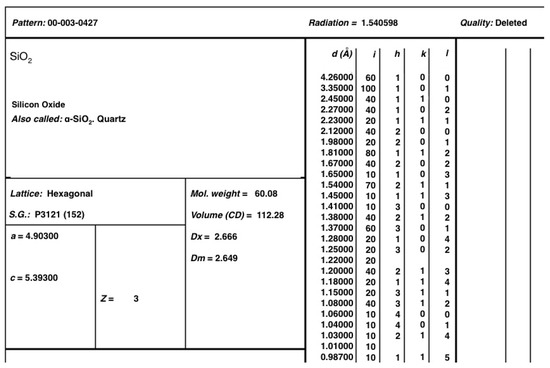
Figure 6.
Fragment of the quartzite elementary cell card 00-003-0427.

Figure 7.
Fragment of card 01-085-0621 of the elementary cell of cristobalite.
In addition, the program of the device determined the percentage content of the interplane distances (d) of each phase state, its intensity, and its location. All these data are presented in Table 5.

Table 5.
Characteristics of parameters of the interplane distance of the phase state of bulk-layer embossed lining at 25 °C.
Then, a semi-welded layer was investigated; the result is presented in Figure 8.
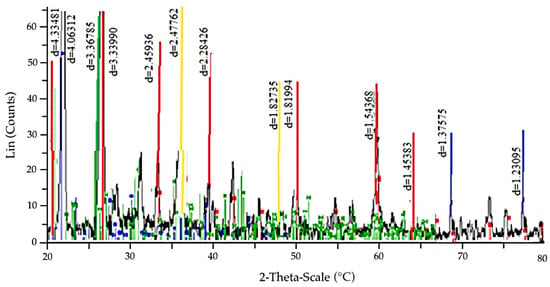
Figure 8.
Diffractogram of semi-welded lining layer, obtained at 25 °C:  —quartzite (card 01-071-0911: a = 5.000 Å, c = 5.4900 Å);
—quartzite (card 01-071-0911: a = 5.000 Å, c = 5.4900 Å);  —cristobalite (card 00-011-0695: a = 4.9710 Å, c = 6.9180 Å);
—cristobalite (card 00-011-0695: a = 4.9710 Å, c = 6.9180 Å);  and
and  —dumortierite silicate (card 01-084-1008: a = 11.89200 Å, b = 20.22190 Å, c = 4.69500 Å).
—dumortierite silicate (card 01-084-1008: a = 11.89200 Å, b = 20.22190 Å, c = 4.69500 Å).
 —quartzite (card 01-071-0911: a = 5.000 Å, c = 5.4900 Å);
—quartzite (card 01-071-0911: a = 5.000 Å, c = 5.4900 Å);  —cristobalite (card 00-011-0695: a = 4.9710 Å, c = 6.9180 Å);
—cristobalite (card 00-011-0695: a = 4.9710 Å, c = 6.9180 Å);  and
and  —dumortierite silicate (card 01-084-1008: a = 11.89200 Å, b = 20.22190 Å, c = 4.69500 Å).
—dumortierite silicate (card 01-084-1008: a = 11.89200 Å, b = 20.22190 Å, c = 4.69500 Å).
Table 6 shows the decoding values of the interplane distances by phase.

Table 6.
Characteristics of the parameters of phase distances of semi-welded layer of embossed lining, at 25 °C.
Figure 9, Figure 10 and Figure 11 show the fragments of quartzite, cristobalite, and dumortierite cards (taken from the device database described above).
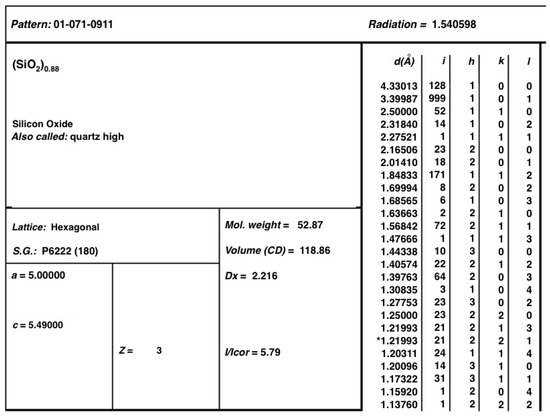
Figure 9.
Fragment of quartzite element card 01-071-0911, where *—interplane distances with a set of Miller indices from the database of the BRUKER D8 ADVANCE diffractometer.
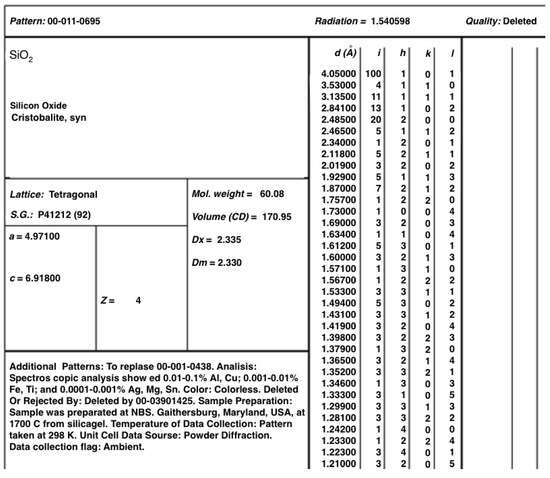
Figure 10.
Fragment of card 00-011-0695 of the elementary cell of cristobalite.
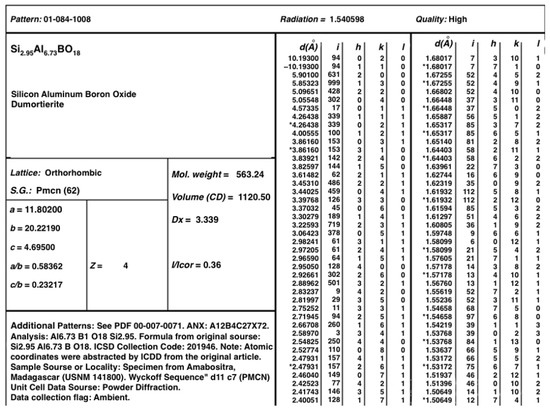
Figure 11.
Fragment of the dumortierite card 01-084-1008 where *—interplane distances with a set of Miller indices from the database of the BRUKER D8 ADVANCE diffractometer.
The following study was performed for the sintered lining layer; the result is shown in Figure 12.
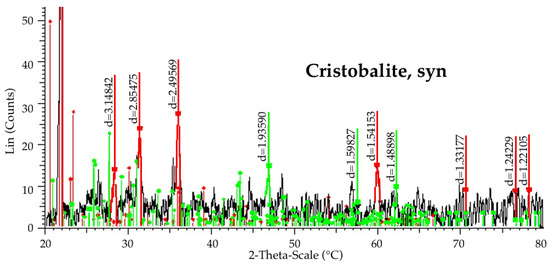
Figure 12.
Diffractogram of sintered lining layer, obtained at 25 °C:  —cristobalite (card 00-011-0695 c a = 4.9710 Å, c = 6.9180 Å);
—cristobalite (card 00-011-0695 c a = 4.9710 Å, c = 6.9180 Å);  —dumortierite silicate (card 01-084-1008: a = 11.89200 Å, b = 20.22190 Å, c = 4.69500 Å).
—dumortierite silicate (card 01-084-1008: a = 11.89200 Å, b = 20.22190 Å, c = 4.69500 Å).
 —cristobalite (card 00-011-0695 c a = 4.9710 Å, c = 6.9180 Å);
—cristobalite (card 00-011-0695 c a = 4.9710 Å, c = 6.9180 Å);  —dumortierite silicate (card 01-084-1008: a = 11.89200 Å, b = 20.22190 Å, c = 4.69500 Å).
—dumortierite silicate (card 01-084-1008: a = 11.89200 Å, b = 20.22190 Å, c = 4.69500 Å).
Table 7 shows an interpretation of the parameters of the interplane distances and their phase affiliations.

Table 7.
Characteristics of the parameters of phase distances of semi-welded layer of the embossed lining, at 25 °C.
For all the diffractograms we collected, the total number of crystalline phases formed was calculated (a content exceeding 5% was considered) and was taken as 100%. Then, the fraction of each crystal phase was determined, and its mean values were calculated: davg—average interplane distance, Davg—average density, Vavg—average volume, and Mavg—averaged lattice molecular mass. The results are presented in Table 8.

Table 8.
Averaged parameters of the embossed lining.
5. Discussion and Conclusions
The results of the embossed lining study show that the use of dumortierite results in an increase in the average values of the volume, density, and molecular mass of the phase composition of the semi-sintered and sintered linings. The lining should provide good resistance to the penetration of the liquid melt into the formed microfractures, and the increase in the content of cristobalite increases its refractory properties.
In addition, an analysis was performed on the use of bulk materials for the smelting of 1 ton of liquid cast iron and was compared with the results of the previous technology, the composition of which is presented in Table 1. Calculations were performed for the smelting of synthetic cast iron used in the manufacture of castings composed of mark CH20 cast iron.
For scrap metal containing 30% steel scrap, the following materials were purchased: 15% (150 kg) of foundry iron at 40 RUB/kg for RUB 6000; 1% (10 kg) of ferromanganese and ferrosilicon at 50 RUB/kg for RUB 500; 30% (300 kg) of scrap at RUB 10 for RUB 3000; and 0.6% for RUB 3 for 18/kg (the remaining mass of scrap metal consisted of the return of production and liquid residue in the kiln; the notional cost of 1 ton, of which 50% was for the liquid residue, and for the return of 80% of the cost of cast iron castings of CH20—70 RUB/kg (330 × 35 = RUB 11500 and 200 × 56 = RUB 11200). The total cost was 32218 RUB/ton of liquid. When used in the metalworking industry, the costs were: 1.5% ferrosilisation at the price of RUB 750, 100 kg of liquid residue at the price of RUB 5000, 88% of steel scrap at the price of RUB 8800, and 2% of carcinger at the price of RUB 60. The total cost of buying fresh materials amounted to RUB 14610. The calculation was based on the market value of the materials in 2018–2019.
Thus, the efficiency of using a sheet consisting of cristobalite and dumortierite allowed for the use of metal filling with 88% of steel scrap and provided a 45.2% reduction in the cost of raw materials.
The continuous operation mode of the ICF-1 furnaces using this technology and performing three melts per shift presented the average resistance of the lining after 360 melts (compared to the speed at which the 300 melts were performed), which allowed us to reduce the downtime required for melting by 12 percent per annum.
Studies of embossed lining have shown the phase composition of each layer and the average values of the parameters of a crystal lattice. This result shows that the use of electrocorundum produces a phase of borosilicate aluminium–dumortierite (Si2.98Al6.81B96O18), with a density 1.3 times higher than that of quartzite (the density of the sintered layer increased by 23%). In addition, there was a 28% increase in cristobalite compared to a semi-finished layer with a higher melting point, thus increasing the fire-resistance quality of the lining. For this reason, it increases the resistance of the lining to the physico-chemical and abrasive effects of the silicate and metal melt, which is a good form of protection against liquid metal that can penetrate the formed microfractures, has a higher refractory value, and can withstand up to 360 melts.
Thus, the phase composition of the new lining, consisting of cristobalite and dumortierite, allowed the smelting of synthetic pig iron from a single scrap of steel during melting temperatures of 1560–1620 °C. This resulted in a 30–40% reduction in the cost of the charge materials, which increased the efficiency of the industrial frequency induction smelters in the foundry and, hence, the overall production rate of the castings.
Author Contributions
Conceptualization, V.A.K., V.V.K., V.S.T. and S.O.K.; methodology, V.A.K., V.V.K., V.S.T., S.O.K., K.A.B. and Y.A.T.; validation, K.A.B., Y.A.T., I.F.V. and A.I.T.; formal analysis, V.A.K., V.S.T., S.O.K., K.A.B., Y.A.T. and I.F.V.; investigation, V.S.T., S.O.K., K.A.B., Y.A.T., I.F.V. and A.I.T.; resources, V.V.K., V.S.T., S.O.K., K.A.B. and Y.A.T.; data curation, V.A.K., K.A.B., Y.A.T., I.F.V. and A.I.T.; writing—original draft preparation, V.A.K., V.V.K., V.S.T., S.O.K., K.A.B., Y.A.T., I.F.V. and A.I.T.; writing—review and editing, V.A.K., A.I.T., V.V.K., V.S.T., S.O.K., K.A.B., Y.A.T. and I.F.V.; visualization, V.V.K., V.S.T., S.O.K., I.F.V. and A.I.T.; supervision, V.S.T., S.O.K., K.A.B., Y.A.T. and A.I.T.; project administration, V.A.K., V.S.T., S.O.K., K.A.B., Y.A.T. and A.I.T. All authors have read and agreed to the published version of the manuscript.
Funding
This research received no external funding.
Institutional Review Board Statement
Not applicable.
Informed Consent Statement
Not applicable.
Data Availability Statement
Not applicable.
Conflicts of Interest
The authors declare no conflict of interest.
References
- Levkina, O.Y. Model of Effective Management of Foundry Production of Aircraft Construction Enterprise. Izv. Samara Sci. Cent. Russ. Acad. Sci. 2012, 14, 454–462. [Google Scholar]
- Weinberg, A.M. Induction Melting Furnaces: Educational Manual for Universities; Energy: Moscow, Russia, 1967; p. 208. [Google Scholar]
- Brockmeier, K. Induction Melting Furnaces; Energy: Moscow, Russia, 1972; p. 304. [Google Scholar]
- Nelyub, V.A.; Fedorov, S.Y.; Malysheva, G.V.; Berlin, A.A. Properties of Carbon Fibers after Applying Metal Coatings on Them by Magnetron Sputtering Technology. Fibre Chem. 2021, 53, 252–257. [Google Scholar] [CrossRef]
- Dibrov, I. State and prospects development of foundry production in Russia. Foundry Prod. Metall. 2021, 6, 6–11. [Google Scholar]
- Tursunov, N.K.; Alimukhamedov, S.P.; Toirov, T.U. Development of effective technology for producing synthetic cast iron in the induction tiger furnace. Univers. Tech. Sci. 2022, 6, 30–33. [Google Scholar]
- Kukartsev, V.A.; Cherepanov, A.I.; Kukartsev, V.V.; Tynchenko, V.S.; Bukhtoyarov, V.V.; Popov, A.M.; Sergienko, R.B.; Tynchenko, S.V. X-Ray Diffraction Phase Analysis of Changes in the Lattice of Pervouralsk Quartzite upon Heating. Minerals 2022, 12, 233. [Google Scholar] [CrossRef]
- Futas, P.; Pribulova, A.; Petrik, J.; Blasko, P.; Junakova, A.; Sabik, V. Metallurgical Quality of Cast Iron Made from Steel Scrap and Possibilities of Its Improvement. Metals 2022, 13, 27. [Google Scholar] [CrossRef]
- Riposan, I.; Chisamera, M.; Stan, S. Enhanced Quality in Electric Melt Grey Cast Irons. ISIJ Int. 2013, 53, 1683–1695. [Google Scholar] [CrossRef]
- Tynchenko, V.S.; Kurashkin, S.O.; Tynchenko, V.V.; Bukhtoyarov, V.V.; Kukartsev, V.V.; Sergienko, R.B.; Bashmur, K.A. Mathematical modeling of induction heating of waveguide path assemblies during induction soldering. Metals 2021, 11, 697. [Google Scholar] [CrossRef]
- Kukartsev, V.A.; Cherepanov, A.I.; Kukartsev, V.V.; Tynchenko, V.S.; Kurashkin, S.O.; Tynchenko, V.V.; Sergienko, R.B.; Bashmur, K.A.; Boyko, A.A.; Bukhtoyarov, V.V. Influence of Moisture in Quartzite on the Lining Properties and Efficiency of Industrial-Frequency Induction Crucible Furnaces. Metals 2022, 12, 1515. [Google Scholar] [CrossRef]
- Kukartsev, V.A. Smelting of cast iron and steel in industrial frequency induction tiger furnaces. Steel 2016, 5, 26–28. [Google Scholar]
- Kukartsev, V.A.; Cherepanov, A.I.; Kukartsev, V.V.; Tynchenko, V.S.; Kurashkin, S.O.; Sergienko, R.B.; Tynchenko, V.V.; Bashmur, K.A. Efficiency of Foundry Production by Changing the Technology of Pretreatment with Quartzite. Metals 2022, 12, 1266. [Google Scholar] [CrossRef]
- Shumihin, V.S.; Luzan, P.P.; Zhelnis, M.V. Synthetic Cast Iron; Scientific Thought: Kiev, Ukraine, 1971; p. 159. [Google Scholar]
- Futáš, P.; Pribulová, A.; Fedorko, G.; Molnár, V. Influence of steel scrap in the charge on the properties of gray cast iron. ISIJ Int. 2017, 57, 374–379. [Google Scholar] [CrossRef]
- Edalati, K.; Akhlaghi, F.; Nili-Ahmadabad, M. Influence of SiC and FeSi Addition on the Characteristics of Gray Cast Iron Melts Poured at Different Temperatures. J. Mater. Process. Technol. 2005, 160, 183–187. [Google Scholar] [CrossRef]
- Weiss, E.; Fedorko, G.; Futáš, P.; Pribulová, A.; Vasková, I. Dependence of Quality Properties for Grey Iron on Used Raw Materials. Metalurgija 2009, 48, 43–45. [Google Scholar]
- Futas, P.; Pribulova, A.; Petrik, J.; Pokusova, M.; Junakova, A. The Study of Synthetic Cast Iron Quality Made from Steel Scrap. In Proceedings of the International Multidisciplinary Scientific GeoConference Surveying Geology and Mining Ecology Management (SGEM), Albena, Bulgaria, 2–8 July 2018. [Google Scholar]
- Krupennikov, S.A.; Filimonov, Y.P. Melting of steel scrap in hot metal. Steel Transl. 2007, 37, 217–219. [Google Scholar] [CrossRef]
- Janerka, K.; Jezierski, J.; Szajnar, J.; Bartocha, D. Analysis of ductile iron production on steel scrap base. Int. J. Cast Met. Res. 2014, 27, 230–234. [Google Scholar] [CrossRef]
- Druzhevsky, M.A.; Pokorni, P. Lining of induction melting furnaces with quartzite-based materials. Refract. Tech. Ceram. 2008, 10, 42–46. [Google Scholar]
- Kukartsev, V.A.; Kukartsev, V.V.; Tynchenko, V.S. Cast Iron and Steel Smelting in Induction Crucible Furnaces of Industrial Frequency. Solid State Phenom. 2020, 299, 530–534. [Google Scholar] [CrossRef]
- Kaibicheva, M.N. Properties of Quartzite Masses Used for the Lining of High-Capacity Induction Furnaces. Refractories 1971, 4, 31–34. [Google Scholar]
- Sassa, V.S. Configuration of Induction Melting Furnaces and Mixers; Energoatomizdat: Moscow, Russia, 1983; p. 120. [Google Scholar]
- Wanl, F.M.; Gnru, R.E.; Gn’ll, R.B. Phase Transformations in Silica as Examined by Continuous X-Ray Diffraction. Am. Miner. 1961, 46, 206. [Google Scholar]
- Golubtsov, V.A. About the Situation in the Domestic Foundry Production. Foundry 2011, 3, 2–3. [Google Scholar]
- Trophimov, M.G. Induction Furnace Lining; Metallurgy: Moscow, Russia, 1968; p. 288. [Google Scholar]
- Zuno-Silva, J.; Bedolla-Jacuinde, A.; Martínez-Vázquez, J.M.; Pérez-Perez, A.; Quintero-Azuara, T. Laboratory-level study of atypical degradation in a SiO2 type refractory used in induction furnaces. Nova Sci. 2014, 6, 113. [Google Scholar] [CrossRef]
- Platonov, B.P.; Akimenko, A.D.; Bagutskaya, S.M. Induction Furnaces for Casting Iron Smelting; Mechanical Engineering: Moscow, Russia, 1976; p. 174. [Google Scholar]
- Fenner, C.N. The Various Forms of Silica and Their Mutual Relations. Jorn. Wasn. Acad. Sei. 1912, 2, 471–480. [Google Scholar]
- Tgoupson, A.B.; Wennemer, M. Heat Capacities and Inversions in Tridymite, Cristobalite, and Tridymite-Cristobalite Mixedphases. Am. Miner. 1979, 64, 1013–1026. [Google Scholar]
- Wenk, H.-R.; Barton, N.; Bortolotti, M.; Vogel, S.C.; Voltolini, M.; Lloyd, G.E.; Gonzalez, G.B. Dauphiné Twinning and Texture Memory in Polycrystalline Quartz. Part 3: Texture Memory during Phase Transformation. Phys. Chem. Miner. 2009, 36, 567–583. [Google Scholar] [CrossRef]
- Ringdalen, E. Changes in Quartz During Heating and the Possible Effects on Si Production. JOM 2015, 67, 484–492. [Google Scholar] [CrossRef]
- Kukartsev, V.A.; Kukartsev, V.V.; Kukartsev, A.V. Effect of the Temperature Treatment of Quartzite on the Lining Resistance of Commercial-Frequency Induction Crucible Furnaces. Refract. Ind. Ceram. 2018, 59, 252–256. [Google Scholar] [CrossRef]
- Kukartsev, V.A.; Trunova, A.I.; Kukartsev, A.V. Thermal Analysis of Quartzite Used to Line a Crucible-Equipped Industrial-Frequency Induction Furnace. Refract. Ind. Ceram. 2014, 55, 220–222. [Google Scholar] [CrossRef]
- Kukartsev, V.A.; Kukartsev, V.V.; Tynchenko, V.S.; Bukhtoyarov, V.V.; Tynchenko, V.V.; Sergienko, R.B.; Bashmur, K.A.; Lysyannikov, A.V. The Technology of Using Liquid Glass Mixture Waste for Reducing the Harmful Environmental Impact. Materials 2022, 15, 1220. [Google Scholar] [CrossRef]
- Kukartsev, V.A.; Kukartsev, V.V.; Tynchenko, V.S.; Kurashkin, S.O.; Sergienko, R.B.; Tynchenko, S.V.; Panfilov, I.A.; Eremeeva, S.V.; Panfilova, T.A. Study of the Influence of the Thermal Capacity of the Lining of Acid Melting Furnaces on Their Efficiency. Metals 2023, 13, 337. [Google Scholar] [CrossRef]
- LLC “Siberian Abrasives”. Available online: http://yuaz.ru (accessed on 13 June 2023).
- Bethechtin, A.G. Course of Mineralogy: Manual; KDU: Moscow, Russia, 2007; p. 721. [Google Scholar]
- Berezhnoy, A.S. Silicon and Its Binary Systems; Academy of Sciences of the Ukrainian SSR: Kiev, Ukraine, 1958; p. 250. [Google Scholar]
- Gorshkov, V.S.; Savelyev, V.G.; Fedorov, N.F. Physical Chemistry of Silicates and Other Refractory Compounds; High School: Moscow, Russia, 1988; p. 400. [Google Scholar]
- Kukartsev, V.A.; Abkaryan, A.K.; Babkin, V.G. Study of the Phase Composition of Spent Quartzite Lining from a Crucible-Type Industrial Frequency Induction Furnace by X-ray Methods. Refract. Ind. Ceram. 2015, 55, 529–531. [Google Scholar] [CrossRef]
- Kukartsev, V.A. Refractory Mass. Patent for An Invention. Russia Patent 2511106, 26 November 2012. [Google Scholar]
- GOST 1412-85. Available online: https://mc.ru/gost/gost1412-85.pdf (accessed on 24 June 2023).
- CH20—Cast Iron Grey Marochnik Steel and Alloys. Available online: http://www.splav-kharkov.com/mat_start.php?name_id=458 (accessed on 24 June 2023).
- ISO 185 JL 200 Gray Cast Iron. Available online: https://www.iron-foundry.com/ISO-185-JL-200-Gray-Cast-Iron.html (accessed on 24 June 2023).
Disclaimer/Publisher’s Note: The statements, opinions and data contained in all publications are solely those of the individual author(s) and contributor(s) and not of MDPI and/or the editor(s). MDPI and/or the editor(s) disclaim responsibility for any injury to people or property resulting from any ideas, methods, instructions or products referred to in the content. |
© 2023 by the authors. Licensee MDPI, Basel, Switzerland. This article is an open access article distributed under the terms and conditions of the Creative Commons Attribution (CC BY) license (https://creativecommons.org/licenses/by/4.0/).